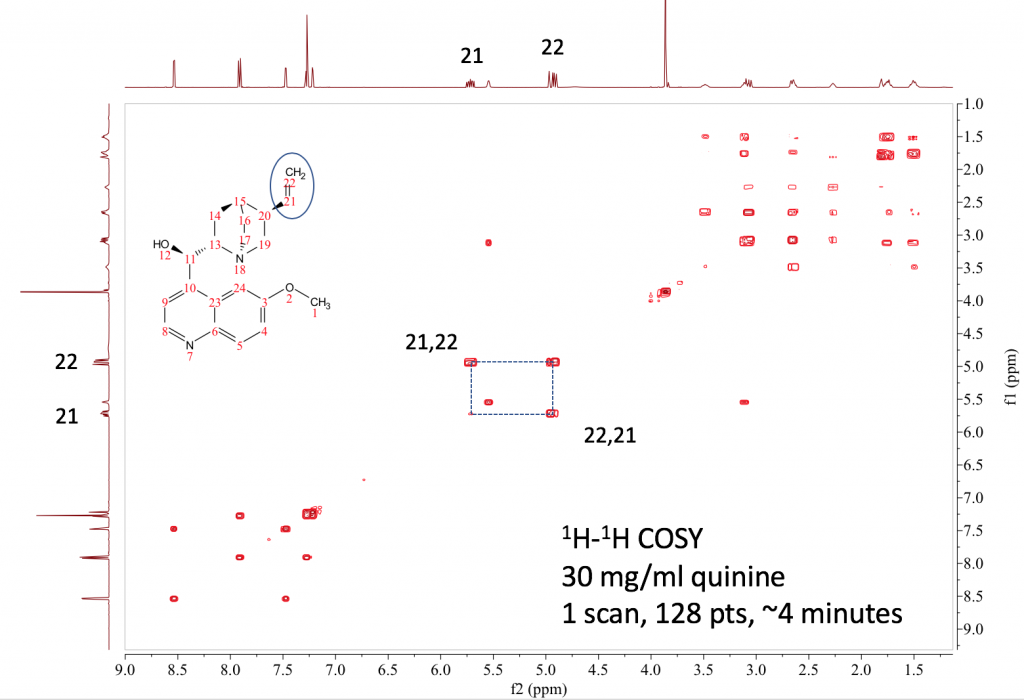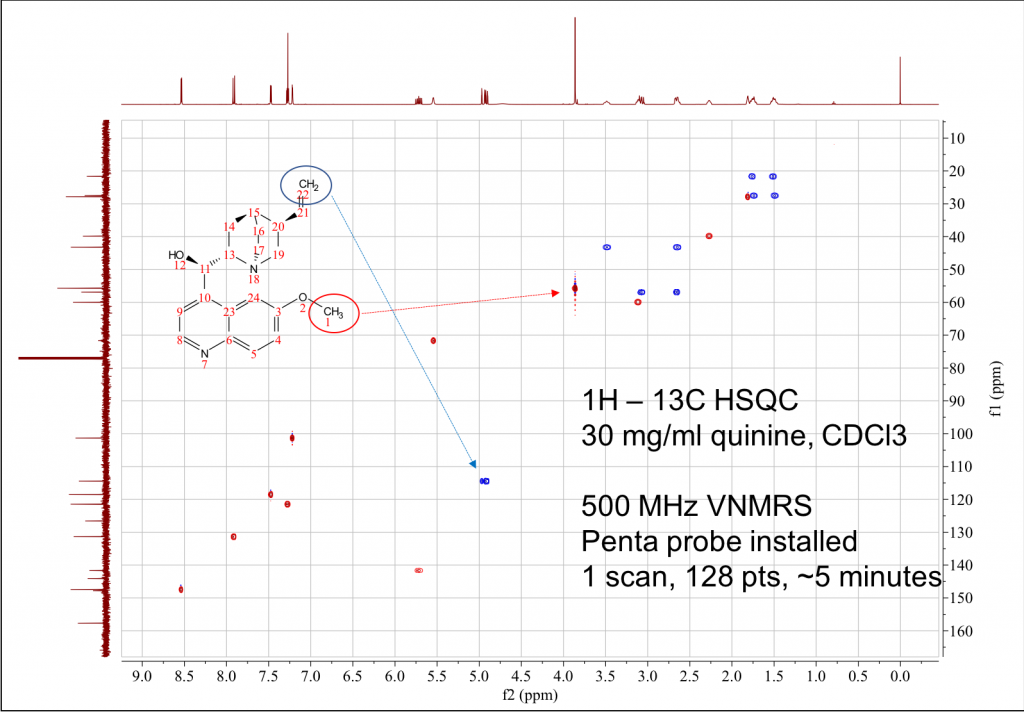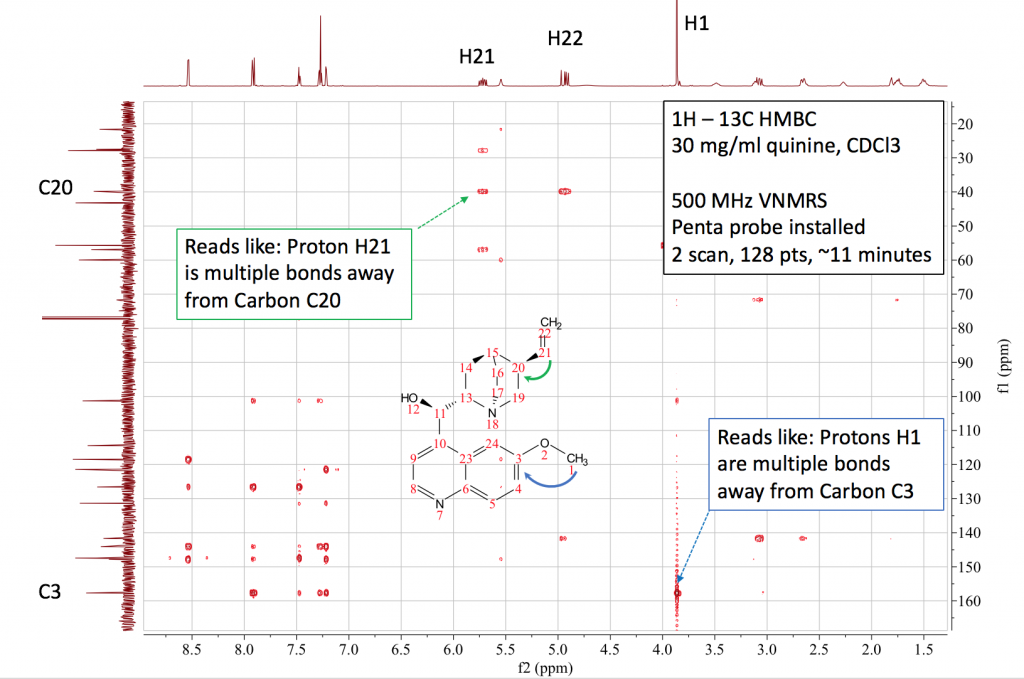7a) Experiment: (HH) COSY:
Before you start: Make sure sample preparation is good (no undissolved material, at least 4.5 cm sample height). Also, you need to make sure the 1H channel is tuned. If you are using an auto-tuned probe (like the NMR400 or NMR500 autox probes), this step will happen automatically. If you are on the NMR500 equipped with penta probe, you must tune the probe manually
Gained Information: The COrrelation SpectroscopY (COSY) NMR experiment is a proton-detected 2D experiment that shows you protons that are J-coupled. You will see your 1H spectrum on both axis, and you will see a cross peak for any protons that are J-coupled. Note, the Double Quantum Filtered COSY (DQF-COSY) often gives cleaner results than the regular COSY, but at a cost of reduced signal intensity. It is recommended that you use the DQF-COSY if you have good sample concentration, and you observe sharp singlets (ie methyls) in your 1H spectrum.
7a) Setting Up 1H-1H COSY in VnmrJ – Screen Recording

7b) Experiment: (1H-13C) HSQC:
Before you start: Make sure sample preparation is good (no undissolved material, at least 4.5 cm sample height). Also, you need to make sure that both the 1H and 13C channels are tuned. If you are using an auto-tuned probe (like the NMR400 or NMR500 autox probes), this step will happen automatically. If you are on the NMR500 equipped with penta probe, you must tune the probe manually.
Sample Concentration: The HSQC is a proton-detected experiment, so your sensitivity depends on how strong your proton signal is. The two major factors here are 1) sample concentration, and 2) instrument / probe choice. If your sample concentration is high (say 25-30 mg/mL) you can obtain excellent data in minutes (1 scan, 128 points) regardless of the instrument. But as your sample concentration dips you may require more scans and/or to use an indirect-detect probe.
Which instrument should I use?: You can use any…especially if you have high sample concentration. But by far the best instrument/probe combination is to use an indirect-detect probe, like the NMR500 equipped with the penta probe (or the NMR600 TXI HCN liquids probe). This provides about 3x the amount of signal per scan compared to the autox probe, since it is optimized for 1H detect. Signal-to-noise scales as the square root of the number of scans, so the 3x signal boost corresponds to about a 9x time savings. In other words, if you run a 9 hour HSQC overnight on the 500 using the autox probe, you could obtain the same signal to noise ratio using the penta probe for 1 hour.
Gained Information: The Heteronuclear Single Quantum Correlation (HSQC) NMR experiment is a proton-detected 2D experiment that shows you 1H / 13C one-bond connectivity. You will see your 1H spectrum as your direct F2 axis and your 13C spectrum as your indirect F1 axis. You will see a cross peak for any 1H connected to a 13C that is one bond away.
Similarly to the 13C DEPT experiment, where CH/CH3 peaks are phased up and CH2 groups phased down, most HSQC data is collected with multiplicity editing so that CH and CH3 groups are phased “up” while CH2 groups are phased “down”. This can be visualized in your 2D plot by different colors. Therefore, not only can you determine which protons are attached to which carbons, but you also can quickly determine if a group is a CH/CH2/CH3 by the phasing of your 2D HSQC contours. The HSQC is often faster to acquire and more informative than the 1D 13C DEPT experiment, and the same
information is obtained.
7b) Collecting 1H/13C HSQC in VnmrJ – Screen Recording

7c) Experiment: (1H-13C) HMBC:
Before you start: Make sure sample preparation is good (no undissolved material, at least 4.5 cm sample height). Also, you need to make sure that both the 1H and 13C channels are tuned. If you are using an auto-tuned probe (like the NMR400 or NMR500 autox probes), this step will happen automatically. If you are on the NMR500 equipped with penta probe, you must tune the probe manually.
Sample Concentration: See above comments for HSQC. Typically you may need to at least double your number of scans that you chose for your HSQC.
Which instrument should I use?: See above comments for HSQC.
Gained Information: The Heteronuclear Multiple Bond Correlation (HMBC) NMR experiment is a proton-detected 2D experiment that shows you 1H / 13C multiple-bond connectivity. You will see your 1H spectrum as your direct F2 axis and your 13C chemical shifts as your indirect F1 axis. Any observed cross-peaks indicate protons that share multiple bond long-range J-coupling with carbons, say in the range of 3-10 Hz. 7-8 Hz is a great choice when setting your target long-range J-coupling constant.
HMBC data is primarily used to confirm and reject proposed NMR assignments. For example, if you had mistakenly swapped assignments for C20 and C13 in the quinine example below, you would have caught the incorrect assignment after noticing that H21 should not give an HMBC correlation to C13, but an observed HMBC correlation to C20 is consistent with the structure.
The screen recording can be found here:
7c) Collecting 1H/13C HMBC in VnmrJ – Screen Recording

